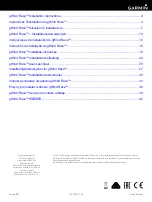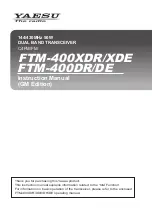
Page
24
of
25
trace in this 'scope screenshot. The lower trace shows the signal at the BS170 gates (the old 5V peak-peak squarewave
from IC3 pin 3). Again please ignore "ringing", and unpleasant notches on the trace (explanation: 'scope probes, long
ground clip wires, 'scope limited bandwidth, you name it, let's not debate it right now). Note the vertical scale 10V/div and
that this ugly drain waveform is 40V peak-peak. The Low Pass Filter will subsequently sort this out and make a beautiful
pure sinewave out of it.
If you do not see this big ugly signal at the BS170 drains, the next thing to investigate is where the BS170's get their
supply power from. Check L4 carefully, a common mistake with toroids is the failure to burn/scrape away the enamel
coating on the wire, resulting in no electrical connection. No electrical connection means no voltage will reach the PA, and
no power output will result. It is easy to check for DC continuity between the pads of L4. Be sure to touch the DVM probes
on the pads, NOT on the wires themselves. If there is no continuity, apply the soldering iron and some more solder and
hold it there for maybe 10 seconds, to burn off the enamel. Some people prefer scraping, I prefer burning.
Now check at the collector of Q6 (MPS751/NPS2907 PNP transistor that performs keying envelope shaping). This is the
junction of Q6 collector and L4. On key-down you should see a DC voltage here (with some superimposed, for sure). The
DC voltage will be your supply voltage minus a volt or so - which is lost in the reverse polarity protection diode D3 at the
transceiver's supply voltage input, and some voltage lost across Q6 itself. If there is no high DC voltage at the Q6
collector, you have to suspect that Q6 might have failed. You also need to check Q4, which is another BS170 MOSFET.
On key-down, you should see approximately 5V DC on its gate; and the source should drop to near ground. Check also
the other components around Q6, make sure that you installed the right components, and that they are all properly
soldered, without shorts or solder bridges etc.


































